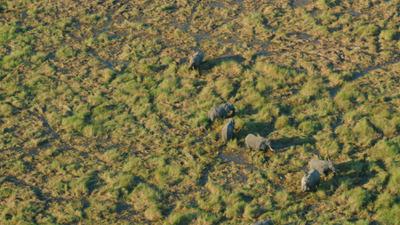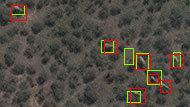Elephants spotted during a scenic flight over the Okavango Delta in Botswana. Diego Cue/Wikimedia Commons
Scientists have developed a new technique for remotely surveying elephants and other wildlife that is quicker and has the same accuracy as human counts done on the ground or in low-flying airplanes. The system, which uses satellite images and deep learning, could help improve the monitoring of endangered species in habitats across the globe.
The research, led by scientists at the University of Bath and the University of Oxford in the United Kingdom, created a computer algorithm to analyze high-resolution satellite images and detect African elephants in both grasslands and forests.
African elephant populations have rapidly declined in the past century, with just 40,000 to 50,000 left in the wild. But on-the-ground or airplane surveys to monitor elephant numbers are expensive and time-consuming. Because satellites can collect over 1,900 square miles of imagery every few minutes, they eliminate the risk of double counting and speed up the process from weeks to a just a few days. Using satellites also cuts down on the logistics of monitoring species populations that cross international borders.
“Accurate monitoring is essential if we’re to save the species,” Olga Isupova, a computer scientist at the University of Bath who co-authored the research, said in a statement. “We need to know where the animals are and how many there are.”
Elephants in woodland as seen from space. Green rectangles show elephants detected by the algorithm, red rectangles show elephants verified by humans. Credit: Maxar Technologies
Scientists have previously developed ways to monitor wildlife populations using satellite images, but they were limited to homogenous habitats, such as tracking whales in the open ocean. The new method is able to count elephants in mixed ecosystems, such as savannah and forests, where tree cover previously would have made satellite tracking difficult. The researchers argue the technology, published in the journal Remote Sensing in Ecology and Conservation, could help make tracking wildlife populations much easier, including for species much smaller than elephants.
“Satellite imagery resolution increases every couple of years, and with every increase we will be able to see smaller things in greater detail,” Isupova said, adding: “Other researchers have managed to detect black albatross nests against snow. No doubt the contrast of black and white made it easier, but that doesn’t change the fact that an albatross nest is one-eleventh the size of an elephant.”




